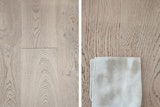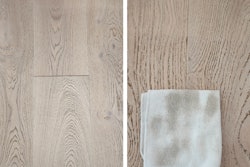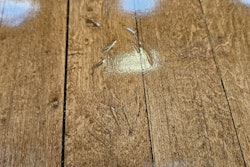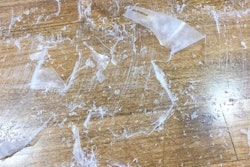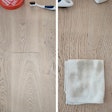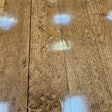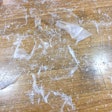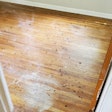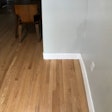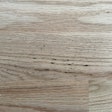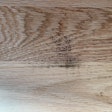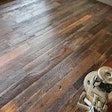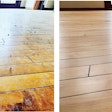The Problem
A contractor in the Southeast received a call two weeks after he put the final coat on a resand and refinish job that the homeowner said was now scuffing and scratching badly. The contractor felt he had done everything right.
The Procedure
The contractor was hired to resand an existing Brazilian cherry floor that previously had been coated with oil-based polyurethane finish. It was about 600 square feet of flooring in the kitchen, breakfast area and family room. Due to concerns about dry times and environmental issues, this time the homeowner had decided on a waterborne finish. Because the homeowner had two large dogs and three small children, the contractor sold her on using an extra coat of finish for extra protection.
The Brazilian cherry strip floor was on a plywood subfloor over a crawl space. The contractor took moisture readings before sanding that showed the floor was at 8 percent MC, which was within the range the contractor expected for that area in June. The HVAC was running during the entire job except when the floor was actually being coated. He sanded the floor and rolled on a seal coat one day, then came back the next day and rolled on three topcoats with about four hours between coats, taking moisture readings between coats to make sure the finish was dry enough. About two weeks after completing the job, the contractor got the phone call that the homeowner was upset about the amount of wear she could already see on her floor.
The Cause
The contractor said he had done everything correctly on the job site, and he seemed to be right. He had applied the finish as instructed and recorded all the relevant moisture readings. In talking with the homeowner, we realized that after 24 hours, the family life on the refinished wood floor, which was a high-traffic area, had resumed as normal, with children, dogs and toys. She said that she was told the floor would be dry after 24 hours, so once it was dry she could use it like she always did.
This problem brings up the difference between dry times and cure times. For most waterborne finishes, the floor is dry enough to move furniture (but not area rugs) back after 24 hours. After that 24 hours the floor should be “gently used” until it is fully cured, which can be from three days to two weeks later depending on the product. Letting two large dogs and children run across the floor with their toys doesn’t qualify as “gently used,” so the problem on this floor was just that it wasn’t allowed to fully cure before taking the brunt of daily family life.
This contractor actually had specified in his contract that the floor could not be subject to regular use until it was fully cured, but the homeowner didn’t read all the details, and she said she didn’t remember him telling her that. Out of goodwill the contractor offered to abrade and recoat the floor at no labor cost if she paid the materials cost.
How to Fix the Floor
The floor must be abraded and recoated.
In the Future
There really can’t be too much communication with homeowners about how to take care of their floors both immediately after recoating and for the longer term. Homeowners who find it unrealistic to wait until full cure for regular daily abuse on the floor should go with a factory finished floor or find a contractor who can do a site-cured UV finish, which cures the finish instantly.










